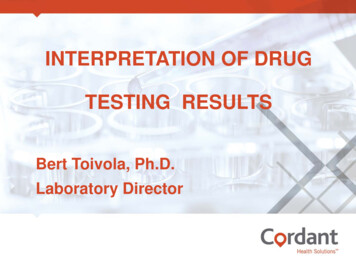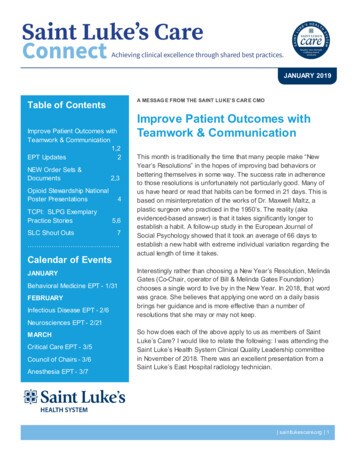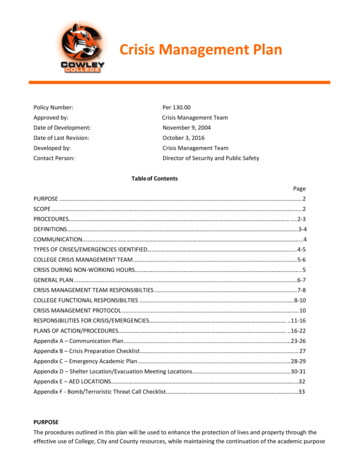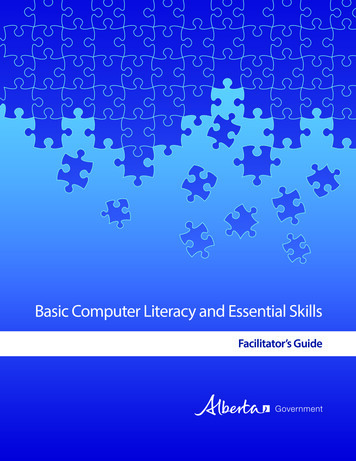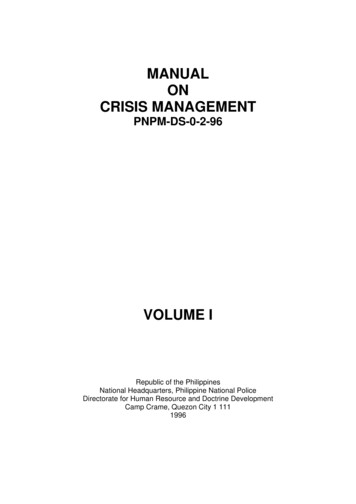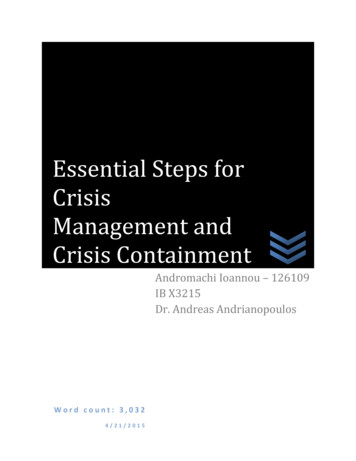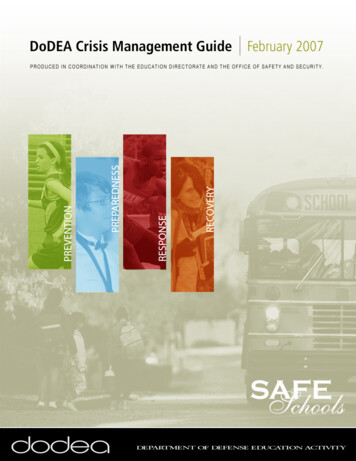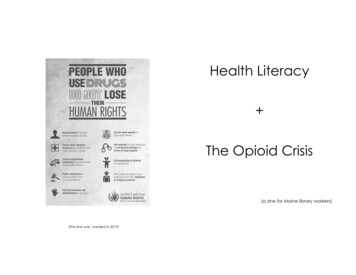
Transcription
Health Literacy The Opioid Crisis(a zine for Maine library workers)(This zine was created in 2019)
Thank you for reading!This zine was created by and with library workers, peoplewho use or have used drugs, community health workers,and harm reduction advocates.Resource roundup - MaineMaine Legislation For their time, guidance, and wisdom, thank you to: Zoe Brokos, Portland Needle ExchangePreble Street Resource CenterOverdose Prevention SocietyAll of our coworkers and friends who provided feedbackPlease feel free to share this zine and to make copies.We hope this will inspire you to learn more, share with yourlibraries, and boldly make changes that benefit yourcommunity.In il.com Governor Mills Executive Orderswww.maine.gov/governor/mills/official documentsMaine Legislature Bill Searchlegislature.maine.govMaine Revised ic Resources for Harm Reduction & Recovery 211 Maine211maine.orgHealth Equity Alliancewww.mainehealthequity.orgMaine Access Pointswww.maineaccesspoints.orgMaine General Harm Reduction ioral-healthservices/harm-reductionMaine Public Health Associationwww.mainepublichealth.orgPortland Needle ProgramPortland Overdose Prevention Societyportlandops.orgPortland Recovery Community Centerwww.portlandrecovery.org
Resource roundupLibrary-Specific Resources National Network of Libraries of Medicine Opioid ic-libraries/opioidresourcesPLA Healthy Community Tools for Public Librariespubliclibrary.healthOpioids & Naloxone Health Literacy Centers for Disease Control: Opioidswww.cdc.gov/drugoverdose/opioidsHarm Reduction Coalition: Recognizing Opioid rdoseMedlinePlus: Naloxone inePlus: Opioid Overdosemedlineplus.gov/opioidoverdoseMedlinePlus: How Naloxone Saves Lives (CC one-saves-lives-inopioid-overdoseNational Resources for Harm Reduction & Recovery Harm Reduction Coalitionharmreduction.orgNorth America Syringe Exchange Network (NASEN)nasen.orgSAMHSA Behavioral Health Treatment Services Locatorfindtreatment.samhsa.govA note about languageWe use people-first language.People-first language uses medically-accurateterminology and puts someone’s humanity first.Instead of You can use.Addicts/JunkiesPeople who use drugsFormer drug addictsPeople who used to use drugs/People in recoveryDrug abuse/AddictionSubstance use/Drug use
OpioidsMaking changeWhat are opioids? Opioids are used to reduce pain. Many are available byprescription. Common opioids include: OxycontinVicodinMorphineHeroinWhat is fentanyl, and why is it so dangerous?Fentanyl is a powerful synthetically manufactured opioid. It isfrequently cut with heroin – intentionally or unintentionally - toincrease its potency. What do policies look like at your library arounddrug use?What does the culture around talking about druguse look like at your library?What would you like to change?What are steps you can take to start thosechanges?What is one step I can take today?Fentanyl is 50-100% more potent than morphine.It is possible to test for fentanyl presence in heroin; however, thetest does not indicate how much is present.Recovery Research Institute
Consequence with compassionAccepting someone exactly as they are does NOT meanthat all behavior is acceptable.When a behavior violates a library policy, at times, weneed to ask that person to leave.If someone is using drugs in your library, there will likely beconsequences for that behavior.What is the point of a consequence?When you find someone using drugs in the library: Speak calmly, clearly, and kindlyFocus on the behavior, not the personOffer a wide range of “takeaway” local resources, notlimited to abstinent sobrietyAsk if they are interested in accessing naloxone orother harm reduction servicesIf possible, determine a return date to discuss re-entryto the libraryAsk the patron what will help them be successful whenthey returnWhat is harm reduction?Harm reduction is a series of strategies designed to minimize the negative consequences associated with highrisk behavior.We use harm reduction tactics every day.
Basic harm reduction principlesFrom the Harm Reduction Coalition:(emphasis is our own)Accepts, for better and or worse, that licit and illicit drug use is part of our world andchooses to work to minimize its harmful effects rather than simply ignore or condemnthem.Understands drug use as a complex, multi-faceted phenomenon thatencompasses a continuum of behaviors from severe abuse to totalabstinence, and acknowledges that some ways of using drugs are clearly safer thanothers.Drug use & library policyTake stock of your present library environment. Establishes quality of individual and community life and well-being–not necessarilycessation of all drug use–as the criteria for successfulinterventions and policies. Calls for the non-judgmental, non-coercive provision of services and resources topeople who use drugs and the communities in which they live in order to assist them inreducing attendant harm.Ensures that drug users and those with a history of drug use routinely have a real voicein the creation of programs and policies designed to serve them.Affirms drugs users themselves as the primary agents of reducing the harms of theirdrug use, and seeks to empower users to share information and support each other instrategies which meet their actual conditions of use. Recognizes that the realities of poverty, class, racism, social isolation, past trauma,sex-based discrimination and other social inequalities affect both people’svulnerability to and capacity for effectively dealing with drug-related harm. Does not attempt to minimize or ignore the real and tragic harm and dangerassociated with licit and illicit drug use.Have staff seen Naloxone and spoken tosomeone who has administered it?Do you have Naloxone at your library? Doyou know who in the library is comfortableusing it?What happens if a staff member administersNaloxone? Is there a policy?Are trainings offered where staff feelcomfortable asking questions?What are policies surrounding data retentionand sharing in regards to patron behavior?Is the priority on supporting library users andthe health and wellbeing of the community,or are we profiling people by anticipatingpotential disciplinary problems?
Book club picksDopesick, by Beth MacyVery well-rounded account of opioiduse, and how over prescribing andincreased manufacture helpedignite the current crisis.Chasing the Scream, by Johann HariThe history of the War on Drugs overthe past century, told in anengaging way through nd benefitseveryone, notjust those whoare directlyimpacted!laura chow, radical roadmapsIn Pain, by Travis RiederUnique perspective of a bioethicist whofirst used opioids after a motorcycleaccident; grapples with his use of drugswithin his professional framework,particularly around pain management.The New Jim Crow, by MichelleAlexanderExplores how the War on Drugscontributed to mass incarceration,particularly of Black men.Community Technical Assistance Center of NYPresentation by Jenna Tine, LCSW & Naomi Weinstein, MPH“Harm Reduction 102” 10/11/18
Harm reduction in practice:Needle exchangesInclusive titleNeedle exchanges provide sterile needles for community members.Clients can also dispose of used needles, obtain Naloxone and sharpsboxes, get tested for HIV and hepatitis C, and discuss questions andconcerns with a healthcare provider. Many needle exchanges also gointo the community to exchange needles with community members.Health Equity Alliance – Bangor304 Hancock Street, Suite 3B, Bangor, ME gimage &eventdescriptionHealth Equity Alliance – Ellsworth5 Long Lane Road, Suite 1, Ellsworth, ME 04605207-667-3506Health Equity Alliance – Machias7 VIP Drive, Machias, ME 04654207-255-5849MaineGeneral Next Step - Augusta9 Green Street, Augusta, ME 04330207-621-3750www.mainegeneral.orgMaineGeneral Next Step – Waterville149 North Street, Waterville, ME 04330207-861-3500Portland Needle Exchange103 India Street, Portland, ME 04101207-756-8024For a national list,check the NorthAmerica SyringeExchange Network:nasen.orgPanelists who are in thecommunity (and who mayhave lived experience usingdrugs)
Harm reduction in your pocket:NaloxoneSmart programmingNaloxone binds to opioid receptors, temporarilyblocking the effects of opioids.Stigmatizingimage anddescriptionThe only function Naloxone serves is reversingan opioid overdose.It is not mood-altering, not habit forming, andhas no street value.Who are ourcommunityleaders?It is available in two forms: nasal spray andintramuscular injection*.Community access to Naloxone is endorsed bythe American Medical Association, the WorldHealth Organization, & the National Institutes ofHealth.*Pass me a Kleenex, please Authoritarian, recovery-focused panelNarcan is a brand of Naloxone. Muchlike “Kleenex” and “tissue,” these termsare used interchangeably, but theyrefer to the same thing. Narcan is abrand name, while Naloxone is thegeneric.
Where to obtain NaloxoneIn Maine, you can get Naloxone through a pharmacy without aprescription. You can also obtain a prescription from your doctor. Thereare no age restrictions.It is legal to carry Naloxone. It cannot be confiscated by lawenforcement.Organizations who distribute Naloxone in Maine are:Health Equity Alliance304 Hancock Street, Suite 3B, Bangor, ME 04401207-990-3626www.mainehealthequity.orgMaine Access ineaccesspoints.orgPortland Needle Exchange103 India Street, Portland, ME 04101207-756-8024On February 6, 2019, GovernorMills signed Executive Order 2:“An Order To ImplementImmediate Responses ToMaine’s Opioid Epidemic.”Maine purchased 35,000 dosesto be distributed to individualsand organizations.Favorite booksOur Top Two SuggestionsThe Opioid Epidemic, by Yngvild Olsen and Joshua M. SharfsteinOxford University Press, 2019 ( 16.95)Over the Influence: The Harm Reduction Guide for ManagingDrugs & Alcohol, by Patt DenningGuilford Publishing, 2017 ( 16.95)Other Suggested TitlesAmerican Fix: Inside the Opioid Addiction Crisis - and How to End It, byRyan HamptonBuzzed: The Straight Facts About the Most Used and Abused Drugs FromAlcohol to Ecstasy, by Cynthia KuhnFighting for Space: How a Group of Drug Users Transformed One City’sStruggle With Addiction, by Travis LupickOvercoming Opioid Addiction: The Authoritative Medical Guide forPatients, Families, Doctors, and Therapists, by Adam BisagaUnbroken Brain: A Revolutionary New Way of Understanding Addiction,by Maia SzalavitzWoman of Substances: A Journey into Drugs, Alcohol, and Treatment, byJenny Valentish
Overdose factsAs library workers, we do not haveto decide for individuals whetherharm reduction or recovery is the“correct” path.Opioids affect the brain stem, which is responsible forbreathing. When you take opioids, it slows yourbreathing rate. When an overdose occurs, yourbreathing rate is so depressed that it stops.Physical Signs of an Overdose(From the Harm Reduction Coalition) Harm reduction is supported byauthoritative medical bodies.We have a professional obligationto make harm reduction materialsavailable in our libraries. Loss of consciousnessUnresponsive to outside stimulusAwake, but unable to talkBreathing is very slow and shallow, erratic, or hasstoppedFor lighter skinned people, the skin tone turns bluishpurple. For darker skinned people, it turns grayish orashen.Choking sounds, or a snore-like gurgling noiseVomitingBody is very limpFace is very pale or clammyFingernails and lips turn blue or purplish blackPulse (heartbeat) is slow, erratic, or not there at all
Public perceptionIn 2019, Information, Communication & Society published a study thatanalyzed posts and comments related to opioid use. The researchersreviewed Facebook pages of 42 Ohio newspapers between 2013 and2017. The researchers found posts fit into four frames:Awareness of the Opioid Epidemic & Affected Populations (34.0%)‘Are police warning about fentanyl on shopping carts?’ - Springfield News-SunPrograms, Policies, and Interventions (29.5%)‘Heroin leading overdose calls: First responders stressed’ - Portsmouth Daily TimesCrime, Punishment, Legal Cases, and Law Enforcement (28.2%)‘67 grams of black tar heroin seized in arrests’ - Portsmouth Daily TimesNarratives of Addiction and the Long Road to Recovery (8.3%)So does Maine’s! Seeour page on GoodSamaritan Law.‘Ohio’s lieutenant governor reveals sons’ opioid addictions’ - Akron Beacon JournalFacebook comments on these stories fit into five themes*:Emotion and SupportGet yourself clean, kid! Stay clean!! You got this!Choice and ResponsibilityDisease and TreatmentWorthinessYou mess with the bull, you get the horns.Addiction is a terrible illness.I can think of many ways that money could be better spent.Attention and ActionNeed to go after the Doctors who prescribe it .“News organizations actively promoted the opioid epidemic as an issueworthy of increased attention, including through a near-constant streamof crime reporting and overdose coverage. Some of this reporting,especially stories with minimal context or investigative resources maypromote stigmatization of opioid use.”David Russell, Naomi J. Spence & Kelly M. Thames (2019) ‘It’s so scary how common this isnow:’ frames in media coverage of the opioid epidemic by Ohio newspapers and themes inFacebook user reactions. Information, Communication & Society, 22:5, 702-708.*Actual quotes from the study
Naloxone & overdose training resourcesin MaineCommon questions about overdoseYou do not need special training to administer Naloxone.However, training provides many benefits for you and your organization,including: Providing Naloxone dispensers for staff to handle Asking questions in a nonjudgmental environment Learning firsthand from someone who has administered Naloxone Allowing for open conversation about thoughts, fears, anxieties, andunknownsCan I overdose by touching someone who has?Organizations in Maine who provide training are:No. Naloxone will have no effect on someone who is notoverdosing.Health Equity mainehealthequity.orgWill I hurt someone by administering Naloxone if theyaren’t overdosing?How long does Naloxone take to work?Naloxone does not work instantaneously. It may take 3-5minutes for someone to begin breathing.Maine Access ccesspoints.orgMaineGeneral's Prevention & HealthyLiving program(207) 872-4102www.mainegeneral.orgOpioids cannot be absorbed through skin contact. Youcannot overdose by touching someone who has usedopioids.Will someone have a violent response after I Portland Needle Exchange103 India Street, Portland, ME /Needle-Exchange-ProgramNaloxone itself does not create a violent reaction;however, it does induce withdrawal symptoms, whichcan make someone disoriented and sick.
Good Samaritan Law in MaineMaine has established Good Samaritan law that coverslibrary workers.Title 14, Section 164, Immunity from Civil Liability, states:“.[A]ny person who voluntarily[ ] renders first aid, emergencytreatment or rescue assistance to a person who is unconscious,ill, injured or in need of rescue assistance, shall not be liable fordamages for injuries alleged to have been sustained by suchperson nor for damages for the death of such person.”Maine also has established Good Samaritan lawprotecting those who call 911.In May 2019, Governor Mills signed into law LD 329, An Act ToExempt from Criminal Liability Persons Reporting a Drug-relatedMedical Emergency.“This bill exempts from arrest or prosecution a person who ingood faith seeks medical assistance for another personexperiencing a drug-related overdose or who is experiencing adrug-related overdose and is in need of medical assistance.”This means someone does not have to hide drugs or drugparaphernalia before calling 911. (This law does not protectsomeone from arrest for outstanding warrants.)A note on 911When making the call: Give as much information as possible about yourlocation. If you are inside of a building, give specifics asto where. Describe what you see, using words such as “notbreathing, turning blue, unconscious, non-responsive,”etc. When the paramedics arrive, give them as muchinformation as you can. Let them know if youadministered Naloxone. In many communities, the police will also respond to a911 call. They may arrive before the paramedics. Ifpossible, stay with the individual until the paramedicsarrive.“The fear of arrest and police involvement issubstantial. Agencies should try to learn fromparticipants what the real risk is and work with policeand emergency personnel to address the fear ofarrest and police involvement.”Harm Reduction Coalition, “Call for Help.”
Chasing the Scream, by Johann Hari The history of the War on Drugs over the past century, told in an engaging way through personal accounts. In Pain, by Travis Rieder Unique perspective of a bioethicist who first used opioids after a motorcycle accident; grapples
